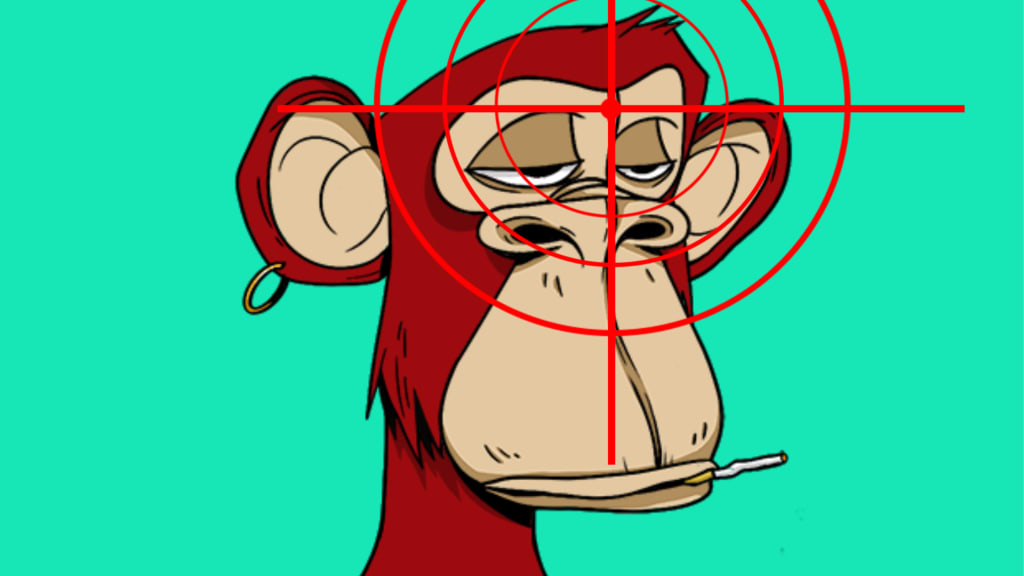
So, first up — a mandatory explanation of NFTs, for those still wrapping their heads around the ugly monkey.
NFTs (Non-Fungible Tokens) are digital assets. They’re non-fungible in that each piece of artwork is totally — verifiably — unique; a bit like how collectible Pokemon cards each have their own serial number. For NFTs, this ‘serial number’ is its connection to the Ethereum blockchain. The blockchain here becomes a sort of ledger, recording each transaction. Now though, instead of a golden Charizard, we have uber-rare Pepe collections. Welcome to the future, baby.
“Har-har I can just screenshot it” — sure, in the same way you can take a shitty, blurry photo of the Mona Lisa at the Louvre. Not really the same thing, is it?
There is a part of NFTs that I admittedly love: it presents an outlet for sick sticker designs, a previously neglected area of digital art. It’s also a fantastic way to support your favourite artists. Artists not only get paid from the initial transaction, but they also receive a cut from every purchase thereafter.
What constitutes the ‘artwork’ that’s sold as an NFT? Near enough anything — infamous full time Youtuber part-time idiot, Logan Paul, sold a low-effort pokemon fighting card of himself.
(Mostly) cool artwork aside, art permanence is another benefit — bit loss is a genuine problem in the digital age: cast your mind to deep-fried screenshots, JPEG compression corroding their definition. So, holding a high-definition ‘original’ does hold ground for digital conservation.
There’s also a desperate attempt for industries to meld NFTs with tangible, physical items, but this is in its infancy. It also feels like a desperate PR move to show boomers ‘Look! See! My 3-million-dollar sticker is useful!!!”. Cringe. Just enjoy your $multi-million Twitter profile in peace, please.
OK — enough baseless cynicism. The real dark side of the NFT market isn’t sickeningly rich celebs: it’s a far more silent beast, lurking in the shadow of the collector’s passion. Investors.
Investors are not interested in artwork; they’re interested in projects. The unbelievable price tags of NFTs are an opportunity. And sure — this can benefit the artist. Not without the greedy middleman carving out his chunk first, however.
Bored Ape has actively supported this process through its selling process. Initial drops of Apes all cost 0.08 ETH ($200ish). This limited release is quickly hoovered up and hosted on Opensea for staggering increases. The cheapest is currently sat at $186,515.79. This inflation does not reflect a change in the art’s value, but instead reflects the hyper-viral tactics that NFTs thrive off. The hype around Bored Ape was frothed up online by celebs such as Bieber and Steph Curry, to incredible results.
And honestly? The biggest NFT projects aren’t even from struggling artists. As we’ve seen, NFT popularity is a major contributor to their value: for already-established celebs, these digital assets are free money printers. Linkin Park’s Mike Shinoda (who sold some of his own NFTs, including a song) talked about Logan Paul’s NFT — in his words, Paul was being “an opportunist crooked jerk.” Aside from blatant crookedness, the reality is — from Musk’s $1.1million-evaluated ‘Vanity Trophy’, to Ellen Degeneres’ $33,495 cat — the more mainstream an NFT creator, the higher its value.
One issue of this popularity is that Ethereum creates a stupendous amount of carbon emissions. Proof-of-work (PoW) is the system wherein Ethereum and some other cryptocurrencies are mined. This is the process where complex cryptographic problems are solved by splitting the workload across as many computers as possible. The strain of processing means each system uses far more electricity than usual.
Since the beginning of 2021, Ethereum’s overall estimated energy use has increased threefold. One Ethereum transaction requires the same amount of electricity as the typical US household uses in a week. Furthermore, as the coin’s value rises, this makes each computing system even less energy-efficient.
Ethereum 2.0 (ETH2) has been promised to reduce the network’s energy usage by 99.95%. This will be a major shift to the proof-of-stake (PoS) mechanism, but the infrastructure has not yet been shifted over.
Anyway, back to the here and now — the ‘mainstream’ component to NFT’s success will be its own undoing.
Short-term, NFT volume is not slowing down. Opensea shows that trading volume for February has been massive. The individual prices have remained largely stagnant, however.
NFT investing strategists such as Matt Blockchain have already pointed out that sell volumes have been higher than buy volumes. Effectively, this is due to Ethereum’s value increase; people have been liquidating their NFTs to cash in on the Ethereum bump. When Ethereum drops, investors will (hopefully) take advantage of the decreased entry and return to the NFT market.
Well, I hear you say, that’s not much of a crash, is it?
Here’s where larger market components come into play.
Research firm Nansen found that NFTs have made huge strides to the ‘mainstream’ in 2021. By the end of last year, total sales volume in the NFT space surpassed 4.6 million ETH, or roughly $17 billion:

Hey! That graph reminds me of something…

This graph displays the creation of an investment bubble. Smart money and institutions naturally get to a new investment vehicle earlier, thanks to their wealth of data and analytical power. As we shift from the awareness phase, to the mainstream ‘mania’ state, shit starts to get crazy.
If you define ‘mainstream’ as ‘the widely-accepted norm’ — NFTs are certainly on their way. Some say they’re already there. Crypto publications have seen NFTs go from niche crypto investments, to clout-carrying Twitter profile pics. They’ve been mentioned everywhere — from The Economist to Nike, Ja Rule to Hollywood studios, and The Evening Standard to The Washington Post.
Where do you think the NFT market is at the moment? ‘Media attention’? Well, we’ve certainly had that.
Enthusiasm? Buying some NFTs isn’t just the purchase of some pixels — it sometimes offers membership to an elite society. If you’ve heard of the Bored Ape Yacht Club, this is a club that — upon purchase of a Bored Ape NFT — you become part of. Currently, there are just over 6,000 members, and perks include…well, not much, yet.
But the sheer hype is tangible. From 12 year olds buying and selling NFTs, to high-end CryptoPunk NFT auctions including a VIP dinner, and major celeb involvement, the excitement is palpable.
Perhaps we’re even at the ‘greed’ stage of the bubble…

Personally, like most crypto side-liners, I welcome the market correction with open arms.
Sure, I’m excited to see how NFTs will evolve alongside VR; I know the market will survive; but I’m sick of ugly monkeys.
Also, the allure of multi-millionaires being publically engulfed in a financial implosion is just so attractive.
About the Creator
Rk.ke
Follow the Omnishambles






Comments
There are no comments for this story
Be the first to respond and start the conversation.